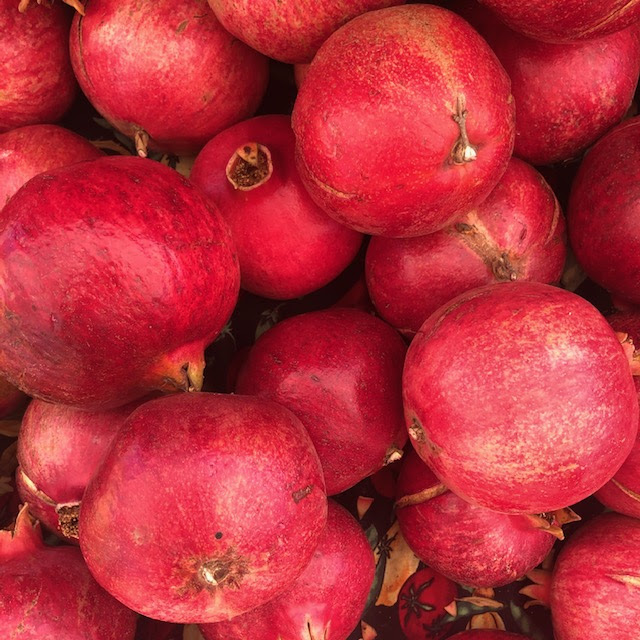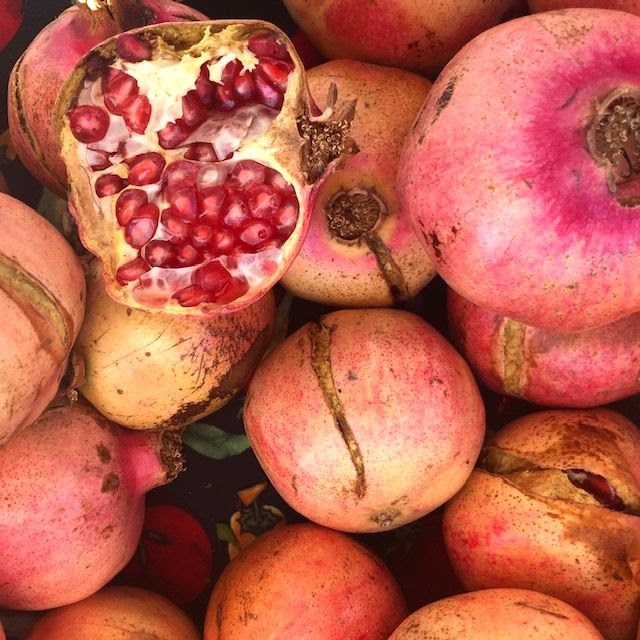Plump, red, and enticing, it’s pomegranate time at the Chico Certified Farmers’ Market! Sweet-tart juice, gem-like seeds, and only in season from about September to January, pomegranates are a precious (and with a little effort, worthwhile) commodity. Pomegranates have been around for a long time and are very prominent in Middle Eastern cuisine. They are said to symbolize death, longevity, paradise, fertility, and temptation, taking on different religious and mythical meaning for many different cultures.
Great in sweet or savory recipes, these jewels (which are actually called arils) will liven up any dish, from salads, entrees, desserts, and edible garnishes, to drinks and cocktails! We know getting to those precious gems inside can be a bit intimidating, but it’s worth it! So keep reading to finally figure out how to master breaking into the pomegranate and get the best out of this seasonal favorite!
- pomegranate2
How to Use
Peeling:
To peel a pomegranate, first cut off the crown and gently scoop out some of the center core without disturbing the seeds. With a sharp knife, score just through the outer rind around the fruit in quarters. Put your thumb in the core center and gently pull apart the sections. Peel away the inner white papery skin covering the seeds and discard. Gently invert the skin inside out and the seeds will pop out to be easily removed without bruising.
Seeding:
To separate the pesky white membrane from the pips, place cut pieces in a bowl of cold water and gently separate the juicy seeds. The membrane pieces should float to the top of the water for easy separation. Just scoop the membrane off, strain, and voila! Seeds galore!
Juicing:
So you want the juice, but not the seeds? Here are a few ways to go about it:
- Use a food mill to grind fresh juice from the seeds, leaving the seeds trapped in the mill.
- Pulse the pips in a blender with short bursts and strain.
- Cut the fruits in half crosswise and ream them as you would a lemon.
- Place the seeds in a sealed plastic freezer bag and roll over them with a rolling pin.
- *Note: Extracting the juice in this way may a touch of bitterness due to abrasion of the seeds, but the bitterness should be minimal if you have a light and patient touch.
You can also slow cook the seeds in a bit of water in a crockpot or on the stovetop, and press through a sieve or cheesecloth to remove the seeds. This method takes more time but results in less bitterness.
- pomegranate3
Nutritional Value
We all know that pomegranates are pretty and tasty, but they are also oh-so-good for you! Pomegranates have anti-oxidant, anti-viral, and anti-tumor properties, as well as being a good source of vitamins, especially vitamin A, C, and E. This fantastic fruit consists of three times as many antioxidants as both wine or green tea!
They are useful in maintaining healthy blood circulation, and have been traditionally used for clearing up the skin and reducing inflammation. They also aid in the treatment of sore throats, heart-related
- pomegranate4
Choosing and Storing
When picking out your prize, choose deeply colored purplish-red pomegranates that feel heavy for their size. Avoid any fruit that is cracked or has soft spots.
When kept in an airtight bag in the refrigerator, whole pomegranates will keep for a month or more. Pomegranate seeds should be refrigerated and used within a few days.



